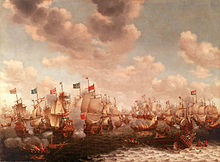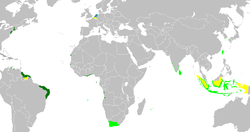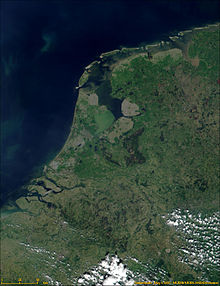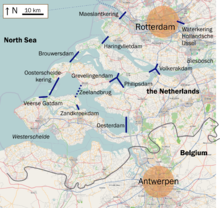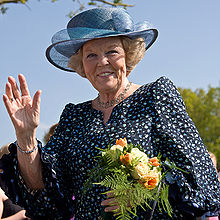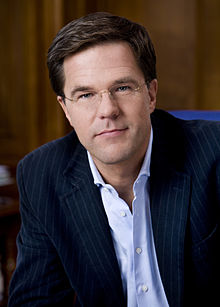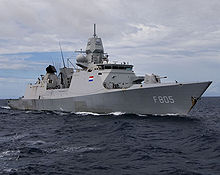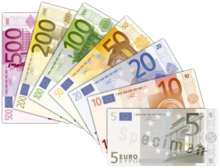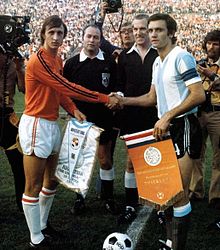- Netherlands
-
This article is about the country within the Kingdom of the Netherlands. For other uses, see Netherlands (disambiguation).
Netherlands Nederland

Flag Coat of arms Motto: Je maintiendrai (French)[1]
(I will maintain)1Anthem: The Wilhelmus Location of the Netherlands (dark green)– in Europe (light green & dark grey)
– in the European Union (light green) — [Legend]Special municipalities of the Netherlands (green)
in the CaribbeanCapital
(and largest city)Amsterdam2
52°19′N 05°33′E / 52.317°N 5.55°EOfficial language(s) Dutch Recognised regional languages Frisian (in Friesland), Papiamento (in Bonaire), English (in Sint Eustatius and Saba)3 Ethnic groups (2008) 80.7% Dutch,
5% EU varieties,
2.4% Indonesians,
2.2% Turks,
2% Surinamese,
2% Moroccans,
0.8% Caribbean
4.8% others[2]Demonym Dutch Government Parliamentary democracy under a constitutional monarch[3] - Monarch Beatrix - Prime Minister Mark Rutte (VVD) - Deputy Prime Minister Maxime Verhagen (CDA) - Current coalition VVD-CDA Coalition Legislature States-General - Upper House Senate - Lower House House of Representatives Independence As result of the Eighty Years' War from the Habsburg Empire - Declared 26 July 1581 - Recognised 30 January 16484 Area - Total 41,848 km2 (135th)
16,158 sq mi- Water (%) 18.41 Population - 2011 estimate 16,733,800[4] (61st) - Density 403/km2 (30th)
1,043.7/sq miGDP (PPP) 2010 estimate - Total $676.895 billion[5] - Per capita $40,764[5] GDP (nominal) 2010 estimate - Total $783.293 billion[5] - Per capita $47,172[5] Gini (2006) 30.9[dated info] (medium) HDI (2011)  0.910[6] (very high) (3rd)
0.910[6] (very high) (3rd)Currency Euro (€): Netherlands5, United States dollar ($): Caribbean Netherlands6 Time zone CET and AST (UTC+1 and −4) - Summer (DST) CEST and AST
(UTC+2 and −4)Drives on the right Internet TLD .nl7 Calling code 31, +5998 1 ^ The official motto is French; the literal translation to English is "I will maintain" (namely, the integrity and independence of the territory)[citation needed] 2 ^ While Amsterdam is the constitutional capital, The Hague is the seat of the government. 3 ^ Frisian (Friesland),[7] Papiamento (Bonaire)[8] and English (Sint Eustatius and Saba)[8] have a formal status in certain parts of the country. Yiddish and the Romani language are recognised as non-territorial languages.[citation needed] Dutch Low Saxon and Limburgish are recognised as regional languages by the European Charter for Regional or Minority Languages. 4 ^ Peace of Westphalia 5 ^ Before 2002: Dutch guilder. 6 ^ The United States dollar is the sole legal tender within the Caribbean Netherlands. Before 2011: Netherlands Antillean guilder. 7 ^ The .eu domain is also used, as it is shared with other European Union member states. 8 ^ 599 is the country code for the now dissolved Netherlands Antilles. The BES islands still use 599-7 (Bonaire), 599-3 (Sint Eustatius) and 599-4 (Saba). The Netherlands
 i/ˈnɛðərləndz/ (Dutch: Nederland [ˈneːdərlɑnt] (
i/ˈnɛðərləndz/ (Dutch: Nederland [ˈneːdərlɑnt] ( listen); West Frisian: Nederlân; Papiamento: Hulanda) is a constituent country of the Kingdom of the Netherlands, located mainly in North-West Europe and with several islands in the Caribbean. Mainland Netherlands borders the North Sea to the north and west, Belgium to the south, and Germany to the east, and shares maritime borders with Belgium, Germany, and the United Kingdom. It is a parliamentary democracy organised as a unitary state. The country capital is Amsterdam and the seat of government is The Hague.[9] The Netherlands in its entirety is often referred to as Holland, although North and South Holland are actually only two of its twelve provinces (a case of pars pro toto; see terminology of "the Netherlands").
listen); West Frisian: Nederlân; Papiamento: Hulanda) is a constituent country of the Kingdom of the Netherlands, located mainly in North-West Europe and with several islands in the Caribbean. Mainland Netherlands borders the North Sea to the north and west, Belgium to the south, and Germany to the east, and shares maritime borders with Belgium, Germany, and the United Kingdom. It is a parliamentary democracy organised as a unitary state. The country capital is Amsterdam and the seat of government is The Hague.[9] The Netherlands in its entirety is often referred to as Holland, although North and South Holland are actually only two of its twelve provinces (a case of pars pro toto; see terminology of "the Netherlands").The Netherlands is a geographically low-lying country, with about 25% of its area and 21% of its population located below sea level,[10] and 50% of its land lying less than one metre above sea level.[11] This distinct feature contributes to the country's name in many other European languages (e.g. German: Niederlande, French: Les Pays-Bas and Spanish: Países Bajos, literally mean "(The) Low Countries"). Significant land area has been gained through land reclamation and preserved through an elaborate system of polders and dikes. Much of the Netherlands is formed by the estuary of three important European rivers, which together with their distributaries form the Rhine-Meuse-Scheldt delta. Most of the country is very flat, with the exception of foothills in the far southeast and several low-hill ranges in the central parts.
The Netherlands was one of the first countries to have an elected parliament. Among other affiliations the country is a founding member of the EU, NATO, OECD and WTO. With Belgium and Luxembourg it forms the Benelux economic union. The country is host to the Organization for the Prohibition of Chemical Weapons and five international courts: the Permanent Court of Arbitration, the International Court of Justice, the International Criminal Tribunal for the Former Yugoslavia, the International Criminal Court and the Special Tribunal for Lebanon. The first four are situated in The Hague as is the EU's criminal intelligence agency Europol and judicial co-operation agency Eurojust. This has led to the city being dubbed "the world's legal capital".[12] The Netherlands has a capitalist market-based economy, ranking 13th of 157 countries according to the Index of Economic Freedom.[13] In May 2011, the Netherlands was ranked as the 'happiest' country according to results published by the Organisation for Economic Co-operation and Development.[14]
Contents
History
Habsburg Netherlands 1519–1581
Main article: History of the Netherlands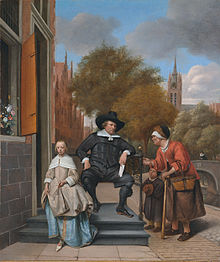 Daily life during the Dutch Golden Age captured in a painting by Jan Steen.
Daily life during the Dutch Golden Age captured in a painting by Jan Steen.
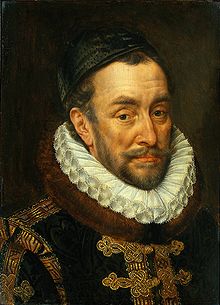 Willem de Zwijger (William the Silent), leader of the Netherlands during the Dutch Revolt.
Willem de Zwijger (William the Silent), leader of the Netherlands during the Dutch Revolt.
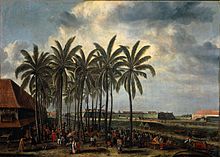 Dutch Batavia built in what is now Jakarta, painting by Andries Beeckman ca. 1656
Dutch Batavia built in what is now Jakarta, painting by Andries Beeckman ca. 1656
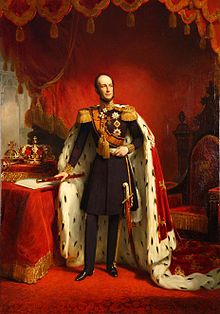 After William II of the Netherlands the monarchs had lost most of their political power
After William II of the Netherlands the monarchs had lost most of their political power
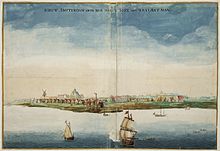 New Amsterdam as it appeared in 1664, before it was exchanged with Great Britain for Suriname. Under British rule it became known as New York.
New Amsterdam as it appeared in 1664, before it was exchanged with Great Britain for Suriname. Under British rule it became known as New York. An anachronous map of the Dutch colonial Empire. Light green: territories administered by or originating from territories administered by the Dutch East India Company; dark green: the Dutch West India Company.
An anachronous map of the Dutch colonial Empire. Light green: territories administered by or originating from territories administered by the Dutch East India Company; dark green: the Dutch West India Company.Under Charles V, Holy Roman Emperor and King of Spain, the Netherlands region was part of the Seventeen Provinces, which also included most of present-day Belgium, Luxembourg, and some land in France and Germany.
The Eighty Years' War between the provinces and Spain began in 1568. In 1579, the northern half of the Seventeen Provinces formed the Union of Utrecht, a treaty in which they promised to support each other in their defense against the Spanish army.[15] The Union of Utrecht is seen as the foundation of the modern Netherlands. In 1581 the northern provinces adopted the Act of Abjuration, the declaration of independence in which the provinces officially deposed Philip II of Spain as reigning monarch in the northern provinces.[16]
Queen Elizabeth I of England sympathised with the Dutch struggle against the Spanish, and in 1585 she concluded a treaty with the Dutch whereby she promised to send an English army to the Netherlands to aid the Dutch in their war with the Spanish.[17] In December 1585, 7,600 soldiers were sent to the Netherlands from England under the command of Robert Dudley, 1st Earl of Leicester.[18] However, the English army was of no real benefit to the Dutch rebellion.[18]
Although Robert Dudley returned to the Netherlands in November 1586 with another army, the army still had little effect in the rebellion.[19] Philip II, the son of Charles V, was not prepared to let them go easily, and war continued until 1648, when Spain under King Philip IV finally recognised the independence of the seven northwestern provinces in the Peace of Münster. Parts of the southern provinces became de facto colonies of the new republican-mercantile empire.
Dutch Republic 1581–1795
Main article: Dutch RepublicAfter independence, the provinces of Holland, Zeeland, Groningen, Friesland, Utrecht, Overijssel, and Gelre formed a confederation known as the Republic of the Seven United Netherlands. All these provinces were autonomous and had their own government, the "States of the Province". The States-General, the confederal government, were seated in The Hague and consisted of representatives from each of the seven provinces. The sparsely populated region of Drenthe, mainly consisting of poor peatland, was part of the republic too, although Drenthe was not considered one of the provinces; it had its own States, but the landdrost of Drenthe was appointed by the States-General. Moreover, the Republic had come to occupy during the Eighty Years' War a number of so-called Generality Lands (Generaliteitslanden in Dutch). These territories were governed directly by the States-General. They did not have a government of their own and did not have representatives in the States-General. Their population was mainly Roman Catholic, and these areas were used as a buffer zone between the Republic and the Southern Netherlands.[citation needed]
The Dutch Empire grew to become one of the major seafaring and economic powers of the 17th century. In the Dutch Golden Age ("Gouden Eeuw"), colonies and trading posts were established all over the world. Dutch settlement in North America began with the founding of New Amsterdam, on the southern tip of Manhattan in 1614. In South Africa, the Dutch settled the Cape Colony in 1652. By 1650, the Dutch owned 16,000 merchant ships.[20] During the 17th century, the Dutch population increased from an estimated 1.5 million to almost 2 million.[21]
For a comprehensive list of the territories that formed the Dutch Empire, see Evolution of the Dutch Empire.Many economic historians regard the Netherlands as the first thoroughly capitalist country in the world. In early modern Europe it featured the wealthiest trading city (Amsterdam) and the first full-time stock exchange. The inventiveness of the traders led to insurance and retirement funds as well as phenomena such as the boom-bust cycle, the world's first asset-inflation bubble, the tulip mania of 1636–1637, and, according to Murray Sayle, the world's first bear raider, Isaac le Maire, who forced prices down by dumping stock and then buying it back at a discount.[22] The republic went into a state of general decline in the later 18th century, with economic competition from England and long standing rivalries between the two main factions in Dutch society, the Staatsgezinden (Republicans) and the Prinsgezinden (Royalists or Orangists) as main factors.[citation needed]
In the 17th century, plantation colonies were established by the Dutch and English along the many rivers in the fertile Guyana plains. The earliest documented colony in Guiana was along the Suriname River and called Marshall's Creek. The area was named after an Englishman.[23] Disputes arose between the Dutch and the English. In 1667, the Dutch decided to keep the nascent plantation colony of Suriname conquered from the English, resulting from the Treaty of Breda. The English were left with New Amsterdam, a small trading post in North America, which is now known as New York City.[citation needed]
French domination 1795–1814
Further information: Batavian Republic and Kingdom of HollandOn 19 January 1795, one day after stadtholder William V of Orange fled to England, the Bataafse Republiek (Batavian Republic) was proclaimed, rendering the Netherlands a unitary state. From 1795 to 1806, the Batavian Republic designated the Netherlands as a republic modelled after the French Republic.
From 1806 to 1810, the Koninkrijk Holland (Kingdom of Holland) was set up by Napoleon Bonaparte as a puppet kingdom governed by his brother Louis Bonaparte in order to control the Netherlands more effectively. The name of the leading province, Holland, was used for the whole country. The Kingdom of Holland covered the area of the present day Netherlands, with the exception of Limburg and parts of Zeeland, which were French territory. In 1807, Prussian East Frisia and Jever were added to the kingdom. In 1809, however, after a failed British invasion, Holland had to give over all territories south of the Rhine to France.
King Louis Bonaparte did not meet Napoleon's expectations – he tried to serve Dutch interests instead of his brother's, allowed trade with the British in spite of the Continental System and even tried to learn Dutch – and he was forced to abdicate on 1 July 1810. He was succeeded by his five-year-old son Napoleon Louis Bonaparte. Napoleon Louis reigned as Louis II for just ten days as Napoleon ignored his young nephew’s accession to the throne. The Emperor sent in an army to invade the country and dissolved the Kingdom of Holland. The Netherlands then became part of the French Empire.
The Netherlands remained part of the French Empire until the autumn of 1813, when Napoleon was defeated in the Battle of Leipzig and forced to withdraw his troops from the country.
Kingdom of the Netherlands 1815–1940
Main articles: United Kingdom of the Netherlands and Kingdom of the NetherlandsWilliam I of the Netherlands, son of the last stadtholder William V van Oranje, returned to the Netherlands in 1813 and became Sovereign Prince of the Netherlands. On 16 March 1815, the Sovereign Prince became King of the Netherlands.
In 1815, the Congress of Vienna formed the United Kingdom of the Netherlands by expanding the Netherlands with Belgium in order to create a strong country on the northern border of France. In addition, William became hereditary Grand Duke of Luxembourg. The Congress of Vienna gave Luxembourg to William as personal property in exchange for his German possessions, Nassau-Dillenburg, Siegen, Hadamar, and Diez.
Belgium rebelled and gained independence in 1830, while the personal union between Luxembourg and the Netherlands was severed in 1890, when King William III of the Netherlands died with no surviving male heirs. Ascendancy laws prevented his daughter Queen Wilhelmina from becoming the next Grand Duchess. Therefore the throne of Luxembourg passed over from the House of Orange-Nassau to the House of Nassau-Weilburg, a junior branch of the House of Nassau.
The largest Dutch settlement abroad was the Cape Colony. It was established by Jan van Riebeeck on behalf of the Dutch East India Company at Cape Town (Dutch: Kaapstad) in 1652. The Prince of Orange acquiesced to British occupation and control of the Cape Colony in 1788. The Netherlands also possessed several other colonies, but Dutch settlement in these lands was limited. Most notable were the vast Dutch East Indies (now Indonesia) and Dutch Guiana (now Suriname). These 'colonies' were first administered by the Dutch East India Company and the Dutch West India Company, both collective private enterprises. Three centuries later these companies got into financial trouble, and the territories in which they operated were taken over by the Dutch government (in 1815 and 1791 respectively). Only then did they become official colonies.
During its colonial period the Netherlands was heavily involved in the slave trade. The Dutch planters relied heavily on African slaves to cultivate the coffee, cocoa, sugar cane and cotton plantations along the rivers. Treatment of the slaves by their owners was notoriously bad, and many slaves escaped the plantations. Slavery was abolished by the Netherlands in Dutch Guiana in 1863, but the slaves were not fully released until 1873, after a mandatory 10 year transition period during which time they were required to work on the plantations for minimal pay and without state sanctioned torture. As soon as they became truly free, the slaves largely abandoned the plantations where they had suffered for several generations in favor of the city Paramaribo. Every year this is remembered during Keti Koti, 1 July, Emancipation Day (end of slavery).
During the 19th century, the Netherlands was slow to industrialize compared to neighbouring countries, mainly because of the great complexity involved in modernizing the infrastructure, consisting largely of waterways, and the great reliance its industry had on windpower.
Although the Netherlands remained neutral during World War I, it was heavily involved in the war.[24] German general Count Schlieffen, who was Chief of the Imperial German General Staff had originally planned to invade the Netherlands while advancing into France in the original Schlieffen Plan. This was changed by Schlieffen's successor Helmuth von Moltke the Younger in order to maintain Dutch neutrality. Later during the war Dutch neutrality proved essential to German survival until the blockade by Great Britain in 1916, when the import of goods through the Netherlands was no longer possible. However, the Dutch were able to continue to remain neutral during the war using their diplomacy and their ability to trade.[24]
Second World War 1940–1945
Main article: History of the Netherlands (1939–1945)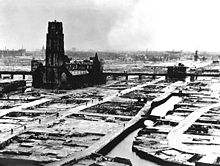 Rotterdam after German air raids in 1940.
Rotterdam after German air raids in 1940.
The Netherlands intended to remain neutral during the Second World War, although contingency plans involving the armies of Belgium, France and the United Kingdom were drawn up in case of German aggression. Despite this neutrality, Nazi Germany invaded the Netherlands on 10 May 1940 as part of their campaign against the Allied forces. French forces in the south and British ships in the west came to help but turned around quickly, evacuating many civilians and several thousand German prisoners of war from the German elite airborne divisions.
The country was overrun in five days. Only after (but not because of) the bombing of Rotterdam, the main element of the Dutch army surrendered on 14 May 1940, although a Dutch and French force held the western part of Zeeland for some time after the surrender. The Kingdom as such, continued the war from the colonial empire; the government in exile resided in London.
During the occupation, over 100,000 Dutch Jews[25] were rounded up to be transported to Nazi German concentration camps in Germany, German-occupied Poland and German-occupied Czechoslovakia. By the time these camps were liberated, only 876 Dutch Jews survived. Dutch workers were conscripted for forced labour in German factories, civilians were killed in reprisal for attacks on German soldiers, and the countryside was plundered for food for German soldiers in the Netherlands and for shipment to Germany. Although there were thousands[26] of Dutch who risked their lives by hiding Jews from the Germans, as recounted in The Hiding Place by Corrie ten Boom and The Heart Has Reasons[27] by Mark Klempner, there were also thousands[28] of Dutch who collaborated with the occupying force in hunting down hiding Jews. Local fascists and anti-Bolsheviks joined the Waffen-SS in the 4th SS Volunteer Panzergrenadier Brigade Netherlands, fighting on the Eastern Front as well as other units. Racial restrictions were relaxed to the extent that even Asians from Dutch East Indies (Indonesia) units were recruited.[29]
 Dutch resistance members with troops of the US 101st Airborne in Eindhoven during Operation Market Garden in September 1944.
Dutch resistance members with troops of the US 101st Airborne in Eindhoven during Operation Market Garden in September 1944.
On 8 December 1941, the Netherlands declared war on Japan.[30] The government-in-exile then lost control of its major colonial stronghold, the Netherlands East Indies (Indonesia), to Japanese forces in March 1942. "American-British-Dutch-Australian" (ABDA) forces fought hard in some instances but were overwhelmed. During the Japanese occupation of Indonesia, the Japanese interned Dutch civilians and used Dutch and Indos (Eurasians of Dutch and Indonesian descent) alike as forced labour, both in the Netherlands East Indies and in neighbouring countries.[31] This included forcing women to work as "comfort women" (sex slaves) for Japanese personnel.
 Liberation of Eindhoven, September 1944.
Liberation of Eindhoven, September 1944.
The Dutch Red Cross reported the deaths in Japanese custody of 14,800 European civilians out of 80,000 interned and 12,500 of the 34,000 POW captured.[32] A later UN report stated that 4 million people died in Indonesia as a result of famine and forced labour (known as romusha) during the Japanese occupation.[33] Some military personnel escaped to Australia and other Allied countries from where they carried on the fight against Japan. The Japanese furthered the cause of independence for the colony, so that after VE day many young Dutchmen found themselves fighting a colonial war against the new republic of Indonesia.
Princess Juliana of the Netherlands, the only child of Queen Wilhelmina and heir to the throne, sought refuge in Ottawa, Canada, with her two daughters, Beatrix and Irene, during the war. During Princess Juliana’s stay in Canada, preparations were made for the birth of her third child. To ensure the Dutch citizenship of this royal baby, the Canadian Parliament passed a special law declaring Princess Juliana's suite at the Ottawa Civic Hospital “extraterritorial”.
On 19 January 1943, Princess Margriet was born. The day after Princess Margriet's birth, the Dutch flag was flown on the Peace Tower. This was the only time in history a foreign flag has waved above Canada’s Parliament Buildings. In 1944–45, the First Canadian Army was responsible for liberating much of the Netherlands from German occupation. The joyous "Canadian summer" that ensued after the liberation, forged deep and long-lasting bonds of friendship between the Netherlands and Canada.[34] In 1949, Dutch troops occupied an area of 69 km2 (27 sq mi) of the British zone of occupied Germany and annexed it. At that time, these areas were inhabited by almost 10,000 people.[citation needed]
Recent history 1945–present
After the war, the Dutch economy prospered by leaving behind an era of neutrality and gaining closer ties with neighbouring states. The Netherlands was one of the founding members of the Benelux (Belgium, the Netherlands and Luxembourg) grouping, was among the twelve founding members of the North Atlantic Treaty Organisation (NATO), and was among the six founding members of the European Coal and Steel Community, which would later evolve, via the EEC (Common Market), into the European Union.
The 1960s and 1970s were a time of great social and cultural change, such as rapid ontzuiling (literally: depillarisation), a term that describes the decay of the old divisions along class and religious lines. Youths, and students in particular, rejected traditional mores and pushed for change in matters like women's rights, sexuality, disarmament and environmental issues.
Today, the Netherlands is regarded as a liberal country, considering its drugs policy and its legalisation of euthanasia. On 1 April 2001, the Netherlands became the first nation to allow same-sex marriage.
On 10 October 2010 the Netherlands Antilles—a former country of the Kingdom of the Netherlands in the Caribbean—was dissolved. Referendums were held on each island of the Netherlands Antilles between June 2000 and April 2005 to determine their future status. As a result the islands of Bonaire, Sint Eustatius and Saba (the BES islands) were to obtain closer ties with the Netherlands. This led to the incorporation of these three islands into the country of the Netherlands as special municipalities upon the dissolution of the Netherlands Antilles. The special municipalities are collectively known as the Caribbean Netherlands.
Geography
Main article: Geography of the NetherlandsThe European area of the Netherlands lies between latitudes 50° and 54° N, and longitudes 3° and 8° E.
The country is divided into two main parts by three large rivers, the Rhine (Rijn) and its main distributaries, the Waal and the Meuse (Maas). These rivers functioned as a natural barrier between earlier fiefdoms and hence created traditionally a cultural divide, as is evident in some phonetic traits that are recognizable north and south of these "Large Rivers" (de Grote Rivieren).
The southwestern part of the Netherlands is a river delta and two tributaries of the Scheldt (Westerschelde and Oosterschelde). Only one significant branch of the Rhine flows northeastward, the IJssel river, discharging into the IJsselmeer, the former Zuiderzee ('southern sea'). This river also forms a linguistic divide: people to the east of this river speak Dutch Low Saxon dialects (except for the province of Friesland, which has its own language).[35]
Floods
Main articles: Flood control in the Netherlands, Floods in the Netherlands, and Storm tides of the North SeaOver the centuries, the Dutch coastline has changed considerably as a result of human intervention and natural disasters. Most notable in terms of land loss is the 1134 storm, which created the archipelago of Zeeland in the southwest.
On 14 December 1287, St. Lucia's flood affected the Netherlands and Germany killing more than 50,000 people in one of the most destructive floods in recorded history.[36] The St. Elizabeth flood of 1421 and the mismanagement in its aftermath destroyed a newly reclaimed polder, replacing it with the 72-square-kilometre (28 sq mi) Biesbosch tidal floodplains in the south-centre. The last major flood in the Netherlands took place in early February 1953, when a huge storm caused the collapse of several dikes in the southwest of the Netherlands. More than 1,800 people drowned in the ensuing inundations. The Dutch government subsequently decided on a large-scale program of public works (the "Delta Works") to protect the country against future flooding. The project took more than thirty years to complete.
The disasters were partially increased in severity through human influence. People had drained relatively high lying swampland to use it as farmland. This drainage caused the fertile peat to compress and the ground level to drop, whereby they would lower the water level to compensate for the drop in ground level, causing the underlying peat to compress even more. The problem remains unsolvable to this day. Also, up until the 19th century peat was mined, dried, and used for fuel, further adding to the problem.
To guard against floods, a series of defences against the water were contrived. In the first millennium AD, villages and farmhouses were built on man-made hills called terps. Later, these terps were connected by dikes. In the 12th century, local government agencies called "waterschappen" (English "water bodies") or "hoogheemraadschappen" ("high home councils") started to appear, whose job it was to maintain the water level and to protect a region from floods. (These agencies exist to this day, performing the same function.) As the ground level dropped, the dikes by necessity grew and merged into an integrated system. By the 13th century, windmills had come into use in order to pump water out of areas below sea level. The windmills were later used to drain lakes, creating the famous polders.
In 1932, the Afsluitdijk (English "Closure Dike") was completed, blocking the former Zuiderzee (Southern Sea) from the North Sea and thus creating the IJsselmeer (IJssel Lake). It became part of the larger Zuiderzee Works in which four polders totalling 2,500 square kilometres (965 sq mi) were reclaimed from the sea.[37][38]
Additionally, the Netherlands is one of the countries that may suffer most from climate change. Not only is the rising sea a problem, but also erratic weather patterns may cause the rivers to overflow.[39][40][41]
Delta Works
Main article: Delta WorksAfter the 1953 disaster, the Delta Works were constructed, a comprehensive set of civil works throughout the Dutch coast. The project started in 1958 and was largely completed in 1997 with the completion of the Maeslantkering. A main goal of the Delta project was to reduce the risk of flooding in South Holland and Zeeland to once per 10,000 years (compared to1 per 4000 years for the rest of the country). This was achieved by raising 3,000 kilometers (1,864 mi) of outer sea-dykes and 10,000 kilometers (6,214 mi) of inner, canal, and river dikes, and by closing off the sea estuaries of the Zeeland province. New risk assessments occasionally show problems requiring additional Delta project dyke reinforcements. The Delta project is one of the largest construction efforts in human history[citation needed] and is considered by the American Society of Civil Engineers as one of the seven wonders of the modern world.[citation needed]
Climate
The predominant wind direction in the Netherlands is southwest, which causes a moderate maritime climate, with cool summers and mild winters. This is especially the case with places within direct proximity of the Dutch coastline, which sometimes are over 10 °C (18 °F) warmer (in winter) or cooler (in summer) than places in the (south)east of the country.
The following tables are based on mean measurements by the KNMI weather station in De Bilt between 1971 and 2000:
Climate data for De Bilt (1971–2000 averages), all KNMI locations (1901–2010 extremes). Month Jan Feb Mar Apr May Jun Jul Aug Sep Oct Nov Dec Year Record high °C (°F) 17.2
(63.0)20.4
(68.7)25.6
(78.1)32.2
(90.0)35.6
(96.1)38.4
(101.1)37.1
(98.8)38.6
(101.5)35.2
(95.4)30.1
(86.2)21.1
(70.0)17.8
(64.0)38.6
(101.5)Average high °C (°F) 5.2
(41.4)6.1
(43.0)9.6
(49.3)12.9
(55.2)17.6
(63.7)19.8
(67.6)22.1
(71.8)22.3
(72.1)18.7
(65.7)14.2
(57.6)9.1
(48.4)6.4
(43.5)13.7 Daily mean °C (°F) 2.8
(37.0)3.0
(37.4)5.8
(42.4)8.3
(46.9)12.7
(54.9)15.2
(59.4)17.4
(63.3)17.2
(63.0)14.2
(57.6)10.3
(50.5)6.2
(43.2)4.0
(39.2)9.8 Average low °C (°F) 0.0
(32.0)−0.1
(31.8)2.0
(35.6)3.5
(38.3)7.5
(45.5)10.2
(50.4)12.5
(54.5)12.0
(53.6)9.6
(49.3)6.5
(43.7)3.2
(37.8)1.4
(34.5)5.7 Record low °C (°F) −27.4
(−17.3)−26.8
(−16.2)−20.7
(−5.3)−9.4
(15.1)−5.4
(22.3)−1.2
(29.8)0.7
(33.3)1.3
(34.3)−3.7
(25.3)−8.5
(16.7)−14.4
(6.1)−22.3
(−8.1)−27.4
(−17.3)Precipitation mm (inches) 67
(2.64)48
(1.89)65
(2.56)44
(1.73)62
(2.44)71
(2.8)70
(2.76)58
(2.28)72
(2.83)77
(3.03)81
(3.19)77
(3.03)793
(31.22)Sunshine hours 52 79 114 158 204 186 196 192 133 106 60 44 1,524 Source: Knmi.nl[42] Ice days (maximum temperature below 0 °C) usually occur from December until February, with the occasional rare ice day prior to or after that period. Freezing days (minimum temperature below 0 °C) occur much more often, usually ranging from mid November to late March, but not rarely measured as early as mid October and as late as mid May. If one chooses the height of measurement to be 10 cm. above ground instead of 150 cm., one may even find such temperatures in the middle of the summer.
Warm days (maximum temperature above 20 °C) in De Bilt are usually measured in the time span of April until September, but in some parts of the country such temperatures can also occur in March and October (this is usually not in De Bilt, however). Summer days (maximum temperature above 25 °C) are usually measured in De Bilt from May until August, tropical days (maximum temperature above 30 °C) are rare and usually occur only from June until August.
Precipitation throughout the year is relatively equally shared by each month. Summer and autumn months tend to gather a little bit more precipitation than other months, mainly because of the intensity of the rainfall rather than the frequency of rain days (this is especially the case in summer, when lightning too is much more frequent than otherwise).
The number of sunshine hours is affected by the fact that due to the geographical latitude the length of the days varies between barely eight hours in December and nearly 17 hours in June.
Environment
Further information: List of national parks of the Netherlands and List of extinct animals of the NetherlandsThe Netherlands has 20 national parks and hundreds of other nature reserves. Most are owned by Staatsbosbeheer and Natuurmonumenten and include lakes, heathland, woods, dunes and other habitats.
Phytogeographically, the Netherlands is shared between the Atlantic European and Central European provinces of the Circumboreal Region within the Boreal Kingdom. According to the World Wide Fund for Nature, the territory of the Netherlands belongs to the ecoregion of Atlantic mixed forests.
In 1871 the last old original natural woods (Beekbergerwoud) were cut down, and most woods today are planted monocultures of trees like Scots Pine and trees that are not native to the Netherlands.[citation needed] These woods were planted on anthropogenic heaths and sand-drifts (overgrazed heaths) (Veluwe).
Politics
Main article: Politics of the Netherlands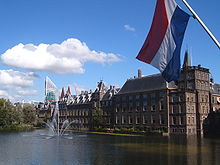 The Binnenhof, where the lower and upper houses of the States-General meet.
The Binnenhof, where the lower and upper houses of the States-General meet.
The Netherlands has been a constitutional monarchy since 1815 and a parliamentary democracy since 1848. The Netherlands is described as a consociational state. Dutch politics and governance are characterised by an effort to achieve broad consensus on important issues, within both the political community and society as a whole. In 2010, The Economist ranked the Netherlands as the tenth most democratic country in the world.
The monarch is the head of state, at present Queen Beatrix. Constitutionally, the position is equipped with limited powers. The monarch can exert some influence during the formation of a new cabinet, where they serve as neutral arbiter between the political parties. Additionally, the king (the title queen has no constitutional significance) has the right to be informed and consulted. Depending on the personality and qualities of the king and the ministers, the king might have influence beyond the power granted by the constitution.
In practice, the executive power is formed by the ministerraad, the deliberative council of the Dutch cabinet. The cabinet consists usually of thirteen to sixteen ministers and a varying number of state secretaries. One to three ministers are ministers without portfolio. The head of government is the Prime Minister of the Netherlands, who often is the leader of the largest party of the coalition. In fact, this has been continuously the case since 1973. The Prime Minister is a primus inter pares, meaning he has no explicit powers beyond those of the other ministers. Currently, the Prime Minister is Mark Rutte.
The cabinet is responsible to the bicameral parliament, the States-General, which also has legislative powers. The 150 members of the House of Representatives, the Lower House, are elected in direct elections, which are held every four years or after the fall of the cabinet (by example: when one of the chambers carries a motion of no-confidence, the cabinet offers its resignation to the monarch). The States-Provincial are directly elected every four years as well. The members of the provincial assemblies elect the 75 members of the Senate, the upper house, which has less legislative powers, as it can merely reject laws, not propose or amend them.
Both trade unions and employers organisations are consulted beforehand in policymaking in the financial, economic and social areas. They meet regularly with government in the Social-Economic Council. This body advises government and its advice cannot be put aside easily.
The Netherlands has a long tradition of social tolerance. In the 18th century, while the Dutch Reformed Church was the state religion, Catholicism and Judaism were tolerated. In the late 19th century this Dutch tradition of religious tolerance transformed into a system of pillarisation, in which religious groups coexisted separately and only interacted at the level of government. This tradition of tolerance is linked to Dutch criminal justice policies on recreational drugs, prostitution, LGBT rights, euthanasia, and abortion, which are among the most liberal in the world.
Political parties
Main article: Political parties of the NetherlandsDue to the multi-party system, no single party has held a majority in parliament since the 19th century, and coalition cabinets had to be formed. Since suffrage became universal in 1919, the Dutch political system has been dominated by three families of political parties: the strongest family were the Christian democrats, currently represented by the Christian Democratic Appeal (CDA), second were the social democrats, of which the Labour Party (PvdA), and third were the liberals, of which the People's Party for Freedom and Democracy (VVD) is the main representative.
These parties cooperated in coalition cabinets in which the Christian democrats had always been a partner: so either a centre left coalition of the Christian democrats and social democrats was ruling or a centre right coalition of Christian democrats and liberals. In the 1970s, the party system became more volatile: the Christian democratic parties lost seats, while new parties became successful, such as the radical democrat and progressive liberal D66.
In the 1994 election, the CDA lost its dominant position. A "purple" cabinet was formed by VVD, D66, and PvdA. In the 2002 elections, this cabinet lost its majority, due to an increased support for the CDA and the rise of the LPF, a new political party around Pim Fortuyn, who was assassinated a week before the elections. A short-lived cabinet was formed by CDA, VVD, and LPF, which was led by CDA leader Jan Peter Balkenende. After the 2003 elections in which the LPF lost most of its seats, a cabinet was formed by CDA, VVD, and D66. The cabinet initiated an ambitious program of reforming the welfare state, the health care system, and the immigration policies.
In June 2006, the cabinet fell after D66 voted in favour of a motion of no confidence against minister of immigration and integration Rita Verdonk, who had instigated an investigation of the asylum procedure of VVD MP Ayaan Hirsi Ali. A care taker cabinet was formed by CDA and VVD, and the general elections were held on 22 November 2006. In these elections, the CDA remained the largest party and the SP made the largest gains. The formation of a new cabinet took three months, resulting in a coalition of CDA, PvdA, and ChristianUnion.
On 20 February 2010, the cabinet fell when the PvdA refused to prolong the involvement of the Dutch Army in Uruzgan, Afghanistan.[43] Snap elections were held on 9 June 2010, with devastating results for the previously largest party, the CDA, which lost about half of its seats, resulting in 21 seats. The VVD became the largest party with 31 seats, closely followed by the PvdA with 30 seats. The big winner of the 2010 elections was Geert Wilders whose PVV more than doubled in number of seats.[44] Negotiation talks for a new government have resulted in a VVD-led minority government in coalition with CDA as of 14 October 2010. This minority government is supported by PVV.[45]
Administrative divisions
Main articles: Provinces of the Netherlands, Municipalities of the Netherlands, Water board (Netherlands), Public body (Netherlands), and Caribbean Netherlands Provinces and special municipalities of the Netherlands.
Provinces and special municipalities of the Netherlands.
The Netherlands is divided into twelve administrative regions, called provinces, each under a Governor, who is called Commissaris van de Koningin (Commissioner of the Queen), except for the province Limburg where the commissioner is called Gouverneur (Governor). All provinces are divided into municipalities (gemeenten), 430 in total (13 March 2010).
The country is also subdivided in water districts, governed by a water board (waterschap or hoogheemraadschap), each having authority in matters concerning water management. As of 1 January 2005 there are 27. The creation of water boards actually pre-dates that of the nation itself, the first appearing in 1196. In fact, the Dutch water boards are one of the oldest democratic entities in the world still in existence.
The administrative structure on the 3 BES islands is different. These Caribbean islands have the status of openbare lichamen (public bodies) and are generally referred to as special municipalities. They are not part of a province.[46]
Provinces of the Netherlands
Flag Province Capital Largest city Area[47]
(km²)Population[48]
1-1-2010Density
(per km²)
Drenthe Assen Assen 2,641 490,981 186 
Flevoland Lelystad Almere 1,417 387,881 274 
Friesland Leeuwarden Leeuwarden 3,341 646,305 193 
Gelderland Arnhem Nijmegen 4,971 1,998,936 402 
Groningen Groningen Groningen 2,333 576,668 247 
Limburg Maastricht Maastricht 2,150 1,122,701 522 
North Brabant 's-Hertogenbosch Eindhoven 4,916 2,444,158 497 
North Holland Haarlem Amsterdam 2,671 2,669,084 999 
Overijssel Zwolle Enschede 3,325 1,130,345 340 
Utrecht Utrecht Utrecht 1,385 1,220,910 882 
Zeeland Middelburg Middelburg 1,787 381,409 213 
South Holland The Hague Rotterdam 2,814 3,505,611 1,246 Total 33,751 16,574,989 491 Special municipalities of the Netherlands
Flag Public body Capital Largest city Area[49]
(km²)Population[50]
1-1-2010Density
(per km²)
Bonaire Kralendijk Kralendijk 294 13,389 46 
Sint Eustatius Oranjestad Oranjestad 21 2,886 137 
Saba The Bottom The Bottom 13 1,737 134 Total 328 18,012 55 Foreign relations
Main article: Foreign relations of the NetherlandsHistorically the Dutch foreign policy was characterised by neutrality, since the Second World War the Netherlands became a member of a large number of international organisations, most prominently the UN, NATO and the EU. The Dutch economy is very open and relies on international trade.
The foreign policy of the Netherlands is based on four basic commitments: to the atlantic cooperation, to European integration, to international development and to international law. One of the more controversial international issues surrounding the Netherlands is its liberal policy towards soft drugs.
During and after its golden age, the Dutch built up a commercial and colonial empire, which fell apart quickly after the Second World War; the historical ties inherited from its colonial past still influence the foreign relations of the Netherlands.
Military
Main article: Military of the NetherlandsThe Netherlands has the oldest standing army in Europe; it was first established as such by Maurice of Nassau. The Dutch army was used throughout the Dutch Empire. After the defeat of Napoleon, the Dutch army was transformed into a conscription army. The army was unsuccessfully deployed during the Belgian revolution in 1830. After 1830, it was deployed mainly in the Dutch colonies, as the Netherlands remained neutral in European wars (including WWI), until the Netherlands was invaded in WWII and quickly defeated by the Wehrmacht in May 1940.
After WWII, the Netherlands dropped their neutrality, and the Dutch army became part of the NATO army strength in Cold War Europe; holding several bases in Germany. In 1996 conscription was suspended, and the Dutch army was once again transformed into a professional army. Since the 1990s the Dutch army has been involved in the Bosnian War, the Kosovo War, has been holding a province in Iraq after the defeat of Saddam Hussein, and was engaged in Afghanistan.
The military is composed of four branches, all of which carry the prefix Koninklijke (Royal):
- Koninklijke Landmacht (KL), the Royal Netherlands Army
- Koninklijke Marine (KM), the Royal Netherlands Navy, including the Naval Air Service and Marine Corps
- Koninklijke Luchtmacht (KLu), the Royal Netherlands Air Force
- Koninklijke Marechaussee (KMar), the Royal Military Police, tasks include military police and border control
General Peter van Uhm is the current Commander of the Netherlands armed forces. All military specialities except the submarine service and the Royal Netherlands Marine Corps (Korps Mariniers) are open to women. The Korps Commandotroepen, the Special Operations Force of the Netherlands Army, is open to women, but because of the extremely high physical demands for initial training, it is almost impossible for women to become a commando.[51] The Dutch Ministry of Defence employs more than 70,000 personnel, including over 20,000 civilian and over 50,000 military personnel.[52] In April 2011 the government decided to decrease the amount of top officials and vehicles considerably, including all tanks, due to a cutback in governmental expenses.[53]
Economy
Main articles: Economy of the Netherlands and List of Dutch companies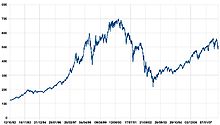 Amsterdam Stock Exchange performance
Amsterdam Stock Exchange performance
The Netherlands has a very strong economy and has been playing a special role in the European economy for many centuries. Since the 16th century, shipping, fishing, trade, and banking have been leading sectors of the Dutch economy. The Netherlands is one of the world's 10 leading exporting countries. Foodstuffs form the largest industrial sector. Other major industries include chemicals, metallurgy, machinery, electrical, goods and tourism. Examples include Unilever, Heineken, financial services (ING), chemicals (DSM), petroleum refining (Shell), electronical machinery (Philips, ASML) and car navigation TomTom.
The Netherlands has the 16th largest economy in the world, and ranks 7th in GDP (nominal) per capita. Between 1997 and 2000 annual economic growth (GDP) averaged nearly 4%, well above the European average. Growth slowed considerably from 2001 to 2005 with the global economic slowdown, but accelerated to 4.1% in the third quarter of 2007. Inflation is 1.3%, and unemployment is at 4.0% of the labour force. By Eurostat standards, unemployment in the Netherlands is at 4.1% (April 2010) – the lowest rate of all European Union member states.[54] The Netherlands also has a relatively low GINI coefficient of 0.326. Despite ranking only 7th in GDP per capita, UNICEF ranked the Netherlands 1st in child well-being.[55] On the Index of Economic Freedom Netherlands is the 13th most free market capitalist economy out of 157 surveyed countries.
Amsterdam is the financial and business capital of the Netherlands.[56] The Amsterdam Stock Exchange (AEX), part of Euronext, is the world's oldest stock exchange and is one of Europe's largest bourses. It is situated near Dam Square in the city's centre. As a founding member of the euro, the Netherlands replaced (for accounting purposes) its former currency, the "Gulden" (guilder), on 1 January 1999, along with 15 other adopters of the Euro. Actual euro coins and banknotes followed on 1 January 2002. One euro was equivalent to 2.20371 Dutch guilders.
The Netherlands' location gives it prime access to markets in the UK and Germany, with the port of Rotterdam being the largest port in Europe. Other important parts of the economy are international trade (Dutch colonialism started with cooperative private enterprises such as the VOC), banking and transport. The Netherlands successfully addressed the issue of public finances and stagnating job growth long before its European partners. Amsterdam is the 5th busiest tourist destination in Europe with more than 4.2 million international visitors.[57]
The country continues to be one of the leading European nations for attracting foreign direct investment and is one of the five largest investors in the United States. The economy experienced a slowdown in 2005, but in 2006 recovered to the fastest pace in six years on the back of increased exports and strong investment. The pace of job growth reached 10-year highs in 2007. The Netherlands moved up from the 11th position in the Global Competitiveness Index[58] to the 9th position in 2007.
One of the largest natural gas fields in the world is situated near Slochteren. Exploitation of this field resulted in a total revenue of €159 billion since the mid 1970s. With just over half of the reserves used up and an expected continued rise in oil prices, the revenues over the next few decades are expected to be at least that much.[59]
Agriculture
A highly mechanised agricultural sector employs 4% of the labour force but provides large surpluses for the food-processing industry and for exports. The Dutch rank third worldwide in value of agricultural exports, behind the United States and France, with exports earning $55 billion annually. A significant portion of Dutch agricultural exports are derived from fresh-cut plants, flowers, and bulbs, with the Netherlands exporting two-thirds of the world's total. The Netherlands also exports a quarter of all world tomatoes, and trade of one-third of the world's exports of chilis, tomatoes and cucumbers goes through the country. The Netherlands also exports one-fifteenth of the world's apples.[60]
Transport
Rotterdam has the largest port in Europe, with the rivers Meuse and Rhine providing excellent access to the hinterland upstream reaching to Basel, Switzerland, and into France. In 2006, Rotterdam was the world's seventh largest container port in terms of Twenty-foot equivalent units (TEU) handled.[61] The port's main activities are petrochemical industries and general cargo handling and transshipment. The harbour functions as an important transit point for bulk materials and between the European continent and overseas. From Rotterdam goods are transported by ship, river barge, train or road. In 2007, the Betuweroute, a new fast freight railway from Rotterdam to Germany, was completed.
Demographics
Main article: Demographics of the NetherlandsThe Netherlands has an estimated population of 16,735,100 (as of 5 November 2011).[62] It is the 11th most populous country in Europe and the 61st most populous country in the world. Between 1900 and 1950, the country's population almost doubled from 5.1 to 10.0 million people. From 1950 to 2000, the population further increased from 10.0 to 15.9 million people, but the population growth decreased compared to the previous fifty years.[63] The estimated growth rate is currently 0.436% (as of 2008).[64]
The fertility rate in the Netherlands is 1.82 children per woman (as of 2011),[64] which is high compared to many other European countries, but below the 2.1-rate required for natural population replacement. Life expectancy is high in the Netherlands: 79 years for newborn girls and 78 for boys (2007). The country has a migration rate of 2.55 migrants per 1,000 inhabitants.
The majority of the population of the Netherlands are ethnically Dutch. A 2005 estimate counted: 80.9% Dutch, 2.4% Indonesian, 2.4% German, 2.2% Turkish, 2.0% Surinamese, 2.0% Moroccan, 0.8% Antillean and Aruban, and 6.0% others.[65] The Dutch are the tallest people in the world, with an average height of 1.81 metres (5 ft 11 in) for adult males and 1.67 metres (5 ft 6 in) for adult females. People in the south are on average about 2 cm shorter than those in the north.[66]
Dutch people, or descendants of Dutch people, are also found in migrant communities worldwide, notably in Canada, Australia, South Africa and the United States. According to the 2006 US Census, more than 5 million Americans claim total or partial Dutch ancestry.[67] There are close to 3 million Dutch-descended Afrikaners living in South Africa.[68] In 1940, there were 290,000 Europeans and Eurasians in Indonesia,[69] but most have since left the country.[70] According to Eurostat, in 2010 there were 4.8 million foreign-born residents in the Netherlands, corresponding to 11.1% of the total population. Of these, 1.4 million (8.5%) were born outside the EU and 0.428 million (2.6%) were born in another EU Member State.[71]
The Netherlands is the 30th most densely populated country in the world, with 395 inhabitants per square kilometre (1,023 /sq mi)—or 484 inhabitants per square kilometre (1,254 /sq mi) if only the land area is counted. It is the 8th most densely populated country in Europe with a population density of 393/km2. The Randstad is the country's largest conurbation located in the west of the country and contains the four largest cities: Amsterdam in the province North Holland, Rotterdam and The Hague in the province South Holland, and Utrecht in the province Utrecht. The Randstad has a population of 7 million inhabitants and is the 6th largest metropolitan area in Europe.
Cities by population 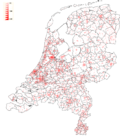
Population density in the Netherlands by neighbourhood as of 2007[72]Rank City Province Population (Urban Area) 1 Amsterdam North Holland 2,788,276 (2,871,870) 2 Rotterdam South Holland 1,854,645 (1,904,051) 3 Den Haag South Holland 850,373 (940,631) 4 Utrecht Utrecht 622,684 (670,484) 5 Eindhoven North Brabant 612,265 (730,480) 6 Tilburg North Brabant 278,065 (229,019) 7 Almere Flevoland 199,709 (-) 8 Groningen Groningen 197,338 (208,847) 9 Breda North Brabant 192,219 (194,708) 10 Nijmegen Gelderland 174,634 (-) 11 Enschede Overijssel 156,109 (-) 12 Apeldoorn Gelderland 156,415 (-) 2008 estimate[73][74] Language
Main article: Languages of the Netherlands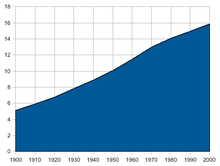 Population of the Netherlands from 1900 to 2000
Population of the Netherlands from 1900 to 2000
The official language is Dutch, which is spoken by the vast majority of the inhabitants. Another official language is Frisian, which is spoken in the northern province of Friesland, called Fryslân in that language. A dialect of Frisian and Dutch is spoken in most villages in the west of the province of Groningen.[75] Frisian is co-official only in the province of Friesland, although with a few restrictions. Several dialects of Low Saxon (Nedersaksisch in Dutch) are spoken in much of the north and east, like the Twents in the Twente region,and Drents in the province Drenthe. They are recognised by the Netherlands as regional languages according to the European Charter for Regional or Minority Languages, as well as the Meuse-Rhenish Franconian varieties in the southeastern province of Limburg, here called Limburgish language.[35] English is an official language in the special municipalities of Saba and Sint Eustatius. It is widely spoken on these islands. Papiamento is an official language in the special municipality of Bonaire. The three islands are known as the BES islands. Yiddish and the Romani language were recognised in 1996 as non-territorial languages.[76]
There is a tradition of learning foreign languages in the Netherlands: about 70% of the total population have good knowledge of conversational English, 55– 59% of German, and 19% of French. The children start with English courses at primary schools when they are about nine years old. English is a mandatory course in all secondary schools.[77] In most lower level secondary school educations (vmbo), one additional modern foreign language is mandatory during the first two years. In higher level secondary schools(havo and vwo), two additional modern foreign languages are mandatory during the first three years. Only during the last three years in vwo one foreign language is mandatory. The standard modern languages are French and German, although schools can change one of these modern languages with Spanish, Turkish, Arabic, or Russian.[78] Additionally, schools in the Frisia region teach and have exams in Frisian, and schools across the country teach and have exams in classical Greek and Latin for vwo.
Religion
Main article: Religion in the NetherlandsThe Netherlands is one of the most secular countries in Western Europe, with only 39% being religiously affiliated (31% for those aged under 35), and fewer than 20% visiting church regularly.[79] According to the most recent Eurobarometer poll 2005,[80] 34% of the Dutch citizens responded that "they believe there is a God", whereas 37% answered that "they believe there is some sort of spirit or life force", and 27% that "they do not believe there is any sort of spirit, god, or life force".
Currently, Roman Catholicism is the single largest religion of the Netherlands, forming the religious home of some 28% of the Dutch population in 2011.[81] The Protestant Church of the Netherlands follows with 16% of the population.[81] It was formed in 2004 as a merger of the two major strands of Calvinism: the Dutch Reformed Church (which represented roughly 8.5% of the population), the Reformed Churches in the Netherlands (3.7% of the population), and a smaller Lutheran Church. Other Protestant churches, mostly orthodox Calvinist splits, represent 6% of the population. In 1947, 44.3% belonged to Protestant denominations, 38.7% belonged to the Roman Catholic Church, and 17.1% were unaffiliated.[82]
In 2006, there were 850,000 Muslims (5% of the total Dutch population).[83] The Netherlands has an estimated 250,000 Buddhists or people who feel strongly attracted by this religion, largely ethnic Dutch people. There are approximately 200,000 Hindus, most of them are of Surinamese origin. Sikhs are another religious minority numbering around 12,000, mainly located in or around Amsterdam. There are five gurudwaras in the Netherlands. The Association of Religion Data Archives (relying on World Christian Encyclopedia) estimated some 6,400 Bahá'ís in 2005.[84]
Although the Holocaust deeply affected the Jewish community (killing about 75% of its 140,000 members at the time[85]), it has managed to rebuild a vibrant and lively Jewish life for its approximately 45,000 current members. Before World War II, 10% of the Amsterdam population was Jewish.[86]
Freedom of education has been guaranteed by the Dutch constitution since 1917, and schools run by religious groups (especially Catholic and Protestant) are funded by the government. All schools must meet strict quality criteria.
Three political parties in the Dutch parliament (CDA, ChristianUnion, and SGP) base their policy on Christian belief in varying degrees. Although the Netherlands is a secular state, in some municipalities where the Christian parties have the majority, the council meetings are opened by prayer.
Municipalities in general also give civil servants a day off on Christian religious holidays, such as Easter and the Ascension of Jesus.[87]
Education
Main article: Education in the NetherlandsEducation in the Netherlands is compulsory between the ages of 4 and 16, and partially compulsory between the ages of 16 and 18.
All children in the Netherlands attend elementary school from (on average) ages 4 to 12. It comprises eight grades, the first of which is facultative. Based on an aptitude test, the 8th grade teacher's recommendation and the opinion of the pupil's parents or caretakers, a choice is made for one of the three main streams of secondary education (after completing a particular stream, a pupil may still continue in the penultimate year of the next stream):
- The vmbo has 4 grades and is subdivided over several levels. Successfully completing the vmbo results in a low-level vocational degree that grants access to the mbo ("middle-level applied education"). With the mbo diploma, a student can apply for the hbo.
- The havo has 5 grades and allows for admission to the hbo ("higher professional education"), which are universities of professional education (or applied sciences) that award professional bachelor degrees that gives access to the university system.
- The vwo (including atheneum and gymnasium) has 6 grades and prepares for studying at a research university. The university consists of a three year bachelor's degree, followed by a one, two or three year master's degree, and finally a four year doctoral degree. Doctoral candidates in the Netherlands are temporary employees of a university.
Culture
Main article: Culture of the NetherlandsThe Netherlands has had many well-known painters. The 17th century, when the Dutch republic was prosperous, was the age of the "Dutch Masters", such as Rembrandt van Rijn, Johannes Vermeer, Jan Steen, Jacob van Ruysdael and many others. Famous Dutch painters of the 19th and 20th century were Vincent van Gogh and Piet Mondriaan. M. C. Escher is a well-known graphics artist. Willem de Kooning was born and trained in Rotterdam, although he is considered to have reached acclaim as an American artist. The Netherlands is the country of philosophers Erasmus of Rotterdam and Spinoza. All of Descartes' major work was done in the Netherlands. The Dutch scientist Christiaan Huygens (1629–1695) discovered Saturn's moon Titan and invented the pendulum clock. Antonie van Leeuwenhoek was the first to observe and describe single-celled organisms with a microscope.
In the Dutch Golden Age, literature flourished as well, with Joost van den Vondel and P.C. Hooft as the two most famous writers. In the 19th century, Multatuli wrote about the poor treatment of the natives in Dutch colonies. Important 20th century authors include Harry Mulisch, Jan Wolkers, Simon Vestdijk, Hella S. Haasse, Cees Nooteboom, Gerard (van het) Reve and Willem Frederik Hermans. Anne Frank's Diary of a Young Girl was published after she died in the Holocaust and translated from Dutch to all major languages.
Replicas of Dutch buildings can be found in Huis Ten Bosch, Nagasaki, Japan. A similar Holland Village is being built in Shenyang, China. Windmills, tulips, wooden shoes, cheese, Delftware pottery, and cannabis are among the items associated with the Netherlands by tourists.
Sport
Main article: Sport in the NetherlandsApproximately 4.5 million of the 16 million people in the Netherlands are registered to one of the 35,000 sports clubs in the country. About two thirds of the population older than 15 years participates in sports weekly.[88]
In the Netherlands, football, speed skating, korfball, handball, swimming, rowing, cycling, field hockey, volleyball, equestrian sports, sailing, and tennis are popular sports. A lot of amateurs practice them, and the Netherlands is a strong competitor in international tournaments for these sports. In the Dutch Caribbean, baseball is a popular sport, with the islands frequently sending teams to the annual Little League World Series.
Organization of sports began at the end of the 19th century and the beginning of the 20th century. Federations for sports were established (such as the speed skating federation in 1882), rules were unified and sports clubs came into existence. A Dutch National Olympic Committee was established in 1912. Thus far, the nation has won 246 medals at the Summer Olympic Games and another 86 medals at the Winter Olympic Games.
Cuisine
Main article: Dutch CuisineSee also
References
- ^ "Wat is het Koninklijk wapen of Rijkswapen? (Google translate)". Official Dutch government website. http://translate.google.com/translate?js=n&prev=_t&hl=nl&ie=UTF-8&layout=2&eotf=1&sl=auto&tl=en&u=http%3A%2F%2Fwww.rijksoverheid.nl%2Fdocumenten-en-publicaties%2Fvragen-en-antwoorden%2Fwat-is-het-koninklijk-wapen-of-rijkswapen.html. Retrieved 8 August 2011.
- ^ World Factbook (3 August 2010). "Netherlands". CIA. https://www.cia.gov/library/publications/the-world-factbook/geos/nl.html. Retrieved 14 August 2010.
- ^ "GovType". United States Department of State website. United States Department of State. 16 July 2010. http://www.state.gov/r/pa/ei/bgn/3204.htm. Retrieved 5 August 2010.
- ^ "Netherlands official population clock". cbs.nl. http://www.cbs.nl/en-GB/menu/themas/bevolking/cijfers/extra/bevolkingsteller.htm. Retrieved 20 July 2010
- ^ a b c d "Netherlands". International Monetary Fund. http://www.imf.org/external/pubs/ft/weo/2011/01/weodata/weorept.aspx?sy=2008&ey=2011&scsm=1&ssd=1&sort=country&ds=.&br=1&c=138&s=NGDPD%2CNGDPDPC%2CPPPGDP%2CPPPPC%2CLP&grp=0&a=&pr.x=40&pr.y=0. Retrieved 6 May 2011.
- ^ "Human Development Report 2011". United Nations. 2011. http://hdr.undp.org/en/media/HDR_2011_EN_Complete.pdf. Retrieved 2 November 2011.
- ^ "Wet gebruik Friese taal in het rechtsverkeer" (in Dutch). wetten.nl. http://wetten.overheid.nl/BWBR0002219/tekst_bevat_Fries/geldigheidsdatum_25-10-2010. Retrieved 25 October 2010.
- ^ a b "Invoeringswet openbare lichamen Bonaire, Sint Eustatius en Saba" (in Dutch). wetten.nl. http://wetten.overheid.nl/BWBR0028063/tekst_bevat_taal%2Bin%2Bhet%2Bbestuurlijk%2Bverkeer/geldigheidsdatum_01-01-2011. Retrieved 1 January 2011.
- ^ Dutch Ministry of Foreign affairs. "About the Nederlands". http://www.minbuza.nl/en/You_and_the_Netherlands/About_the_Netherlands/General_information/The_country_and_its_peopleournal. Retrieved 3 March 2011.[dead link]
- ^ "Milieurekeningen 2008". Centraal Bureau voor de Statistiek. http://www.cbs.nl/NR/rdonlyres/D2CE63F9-D210-4006-B68B-98BE079EA9B6/0/2008c167pub.pdf. Retrieved 4 February 2010.
- ^ "Netherlands Guide – Interesting facts about the Netherlands". Eupedia. 19 April 1994. http://www.eupedia.com/netherlands/trivia.shtml. Retrieved 29 April 2010.
- ^ van Krieken, Peter J.; David McKay (2005). The Hague: Legal Capital of the World. Cambridge University Press. ISBN 9067041858., specifically, "In the 1990s, during his term as United Nations Secretary-General, Boutros Boutros-Ghali started calling The Hague the world's legal capital."
- ^ Netherlands, Index of Economic Freedom
- ^ "Where is the happiest place on Earth? | The Search Office Space Blog | Searchofficespace". News.searchofficespace.com. 2011-05-25. http://news.searchofficespace.com/sos-news/where-is-the-happiest-place-on-earth.html. Retrieved 2011-10-28.
- ^ John Lothrop Motley, The Rise of the Dutch Republic Vol. III (harper Bros.: New York, 1855) p. 411.
- ^ Motley, p. 508.
- ^ David Harris Willson, History of England (Holt,Rinehart & Winston: New York, 1972) p. 294.
- ^ a b Motley
- ^ Garrett Mattingly, The Armada (Houghton Mifflin: Boston, 1959) p. 48.
- ^ "The Middle Colonies: New York ". Digital History.
- ^ The preponderance of the Dutch population lived in two provinces, Holland and Zeeland. This area experienced a population explosion between 1500 and 1650, with a growth from 350,000 to 1,000,000 inhabitants. Thereafter the growth leveled off, so that the population of the whole country remained at the 2 million level throughout the 18th century; De Vries and Van der Woude, pp. 51–52
- ^ "Japan Goes Dutch", London Review of Books (1 April 2001). 3–7.
- ^ Baynes, Thomas Spencer (1888). Encyclopedia Britannica: A Dictionary of ARTS, SCIENCES, and General LITERATURE, Volume XI (Ninth Edition—Popular Reprint ed.). H.G. Allen. http://books.google.com/?id=paQMAAAAYAAJ&pg=PA253&lpg=PA253&dq=marshall's+creek+suriname+river. Retrieved 4 May 2008. "In 1614 the states of Holland granted to any Dutch citizen a four years' monopoly of any harbour or place of commerce which he might discover in that region (Guiana). The first settlement, however, in Suriname (in 1630) was made by an Englishman, whose name is still preserved by Marshall's Creek."
- ^ a b Abbenhuis, Maartje M. The Art of Staying Neutral. Amsterdam: Amsterdam UP, 2006.
- ^ 93 trains[dead link]
- ^ Klempner, Mark. The Heart Has Reasons: Holocaust Rescuers and Their Stories of Courage. Cleveland: The Pilgrim Press, 2006, pg. 15–17.
- ^ [The Heart Has Reasons: Holocaust Rescuers and Their Stories of Courage http://www.hearthasreasons.com] by Mark Klempner Cleveland: The Pilgrim Press, 2006; ISBN 0-8298-1699-2
- ^ Klempner, Mark. The Heart Has Reasons: Holocaust Rescuers and Their Stories of Courage. Cleveland: The Pilgrim Press, 2006, pg. 5.
- ^ MOOXE from Close Combat Series. "Indonesian SS Volunteers". Closecombatseries.net. http://www.closecombatseries.net/CCS/modules.php?name=Forums&file=viewtopic&t=7686&highlight=. Retrieved 2011-10-28.
- ^ "THE KINGDOM OF THE NETHERLANDS DECLARES WAR WITH JAPAN". ibiblio. http://www.ibiblio.org/pha/policy/1941/411208c.html. Retrieved 2 October 2009.
- ^ Library of Congress, 1992, "Indonesia: World War II and the Struggle For Independence, 1942–50; The Japanese Occupation, 1942–45" Access date: 9 February 2007.
- ^ M. Z. Aziz. Japan’s Colonialism and Indonesia. The Hague 1955.
- ^ Cited in: Dower, John W. War Without Mercy: Race and Power in the Pacific War (1986; Pantheon; ISBN 0-394-75172-8)
- ^ Liberation of Holland from The Canadian Encyclopedia.
- ^ a b Welschen, Ad: Course Dutch Society and Culture, International School for Humanities and Social Studies ISHSS, Universiteit van Amsterdam, 2000–2005.
- ^ Zuiderzee floods (Netherlands history). Britannica Online Encyclopedia.
- ^ "Kerngegevens gemeente Wieringermeer". www.sdu.nl. Archived from the original on 6 January 2008. http://web.archive.org/web/20080106163025/http://www.sdu.nl/staatscourant/gemeentes/gem533nh.htm. Retrieved 21 January 2008.
- ^ "Kerngegevens procincie Flevoland". www.sdu.nl. Archived from the original on 26 December 2007. http://web.archive.org/web/20071226115958/http://www.sdu.nl/staatscourant/PROVINCIES/flevoland.htm. Retrieved 21 January 2008.
- ^ Nickerson, Colin (5 December 2005). "Netherlands relinquishes some of itself to the waters". Boston Globe. http://www.boston.com/news/world/europe/articles/2005/12/05/holland_goes_beyond_holding_back_the_tide/. Retrieved 10 October 2007.
- ^ Olsthoorn, A.A.; Richard S.J. Tol (February 2001). "Floods, flood management and climate change in The Netherlands". Institute for Environmental Studies (Institute for Environmental Studies, Vrije Universiteit). http://de.scientificcommons.org/16816958. Retrieved 10 October 2007.
- ^ Tol, Richard S. J.; Nicolien van der Grijp, Alexander A. Olsthoorn, Peter E. van der Werff (2003). "Adapting to Climate: A Case Study on Riverine Flood Risks in the Netherlands". Risk Analysis (Blackwell-Synergy) 23 (3): 575–583. doi:10.1111/1539-6924.00338. PMID 12836850. http://www.blackwell-synergy.com/doi/abs/10.1111/1539-6924.00338. Retrieved 10 October 2007.
- ^ "Knmi.nl" (in Dutch). http://www.knmi.nl/. Retrieved 18 September 2010.
- ^ (Dutch)"Kabinet valt over Uruzgan-besluit". De Volkskrant. 20 February 2010. http://www.volkskrant.nl/binnenland/article1350355.ece/Kabinet_valt_over_Uruzgan-besluit. Retrieved 20 February 2010.[dead link]
- ^ "Lengthy coalition talks loom after far-right gain in Dutch elections". France24. http://www.france24.com/en/20100610-netherlands-government-coalition-elections-party-for-freedom-anti-islam. Retrieved 12 June 2010.
- ^ (German)"Neue niederländische Regierung formiert sich". Der Spiegel. 8 October 2010. http://www.spiegel.de/politik/ausland/0,1518,722177,00.html.
- ^ "31.954, Wet openbare lichamen Bonaire, Sint Eustatius en Saba" (in Dutch). Eerste kamer der Staten-Generaal. http://www.eerstekamer.nl/wetsvoorstel/31954_wet_openbare_lichamen. Retrieved 15 October 2010. "De openbare lichamen vallen rechtstreeks onder het Rijk omdat zij geen deel uitmaken van een provincie.
"Through the establishment of the BES islands as public bodies, rather than communities, the BES islands' rules may deviate from the rules in the European part of the Netherlands. The Dutch legislation will be introduced gradually. The public bodies fall directly under the central government because they are not part of a province."" - ^ "Regionale Kerncijfers Nederland" (in Dutch). Statistics Netherlands. 2007. http://statline.cbs.nl/StatWeb/publication/?VW=T&DM=SLNL&PA=70072ned&D1=224&D2=5-16&D3=l&HD=081103-1603&HDR=T&STB=G1,G2. Retrieved 13 October 2007.
- ^ "Bevolking; geslacht, leeftijd, burgerlijke staat en regio, 1 januari" (in Dutch). Statistics Netherlands. 2010. http://statline.cbs.nl/StatWeb/publication/?DM=SLNL&PA=03759NED&D1=0&D2=129-132&D3=0,5-16,101-902&D4=21-22&HDR=T,G2&STB=G1,G3&VW=T. Retrieved 11 October 2010.
- ^ "Statistical Info: Area and Climate" (in Dutch). Central Bureau of Statistics (Netherlands Antilles). 2010. http://www.cbs.an/area_climate/area_a1.asp. Retrieved 11 October 2010.
- ^ "Statistical Info: Population". Central Bureau of Statistics (Netherlands Antilles). 2010. http://www.cbs.an/population/population_b2.asp. Retrieved 11 October 2010.
- ^ {{KCT}}
- ^ "Ministerie van defensie – Werken bij Defensie". Mindef.nl. http://www.mindef.nl/personeel/werken_bij_defensie/index.aspx. Retrieved 29 April 2010.[dead link]
- ^ "Defensie hard getroffen door bezuinigingen". Ministry of Defence. http://www.defensie.nl/actueel/nieuws/2011/04/08/46180709/Defensie_hard_getroffen_door_bezuinigingen_video. Retrieved 26 April 2011.
- ^ "Eurostat unemployment rates november 2007" (PDF). http://epp.eurostat.ec.europa.eu/pls/portal/docs/PAGE/PGP_PRD_CAT_PREREL/PGE_CAT_PREREL_YEAR_2008/PGE_CAT_PREREL_YEAR_2008_MONTH_01/3-07012008-EN-BP.PDF. Retrieved 7 January 2008.
- ^ "Child Poverty Report Study by UNICEF 2007" (PDF). http://www.unicef.org/media/files/ChildPovertyReport.pdf.
- ^ "Amsterdam – Economische Zaken" (in Dutch). http://www.ez.amsterdam.nl/page.php?menu=24&page=6. Retrieved 22 May 2008.[dead link]
- ^ Amsterdam – Economische Zaken[dead link]
- ^ "Economic development". www.hollandtrade.com. 18 June 2008. http://www.hollandtrade.com/holland-information/economic-development/?gclid=CIfivLDGvJ4CFUgA4wodRk1F1g. Retrieved 27 January 2010.[dead link]
- ^ "Aardgas als smeerolie". Andere Tijden. VPRO. 15 January 2006. Transcript.[dead link]
- ^ "Netherlands: Agricultural situation". USDA Foreign Agriculture Service. http://www.fas.usda.gov/gainfiles/200501/146118432.pdf#search=%22netherlands%20main%20agriculture%20export%20flowers%22. Retrieved 20 June 2007.
- ^ "Port of Rotterdam". Port of Rotterdam. 14 February 2007. Archived from the original on 18 May 2008. http://web.archive.org/web/20080518054012/http://www.portofrotterdam.com/en/home/. Retrieved 29 April 2010.
- ^ CBS – Population counter – Extra. Statistics Netherlands. Retrieved on 8 March 2009.
- ^ CBS Statline – Population; history. Statistics Netherlands. Retrieved on 8 March 2009.
- ^ a b CIA – The World Factbook – Netherlands. Central Intelligence Agency. Retrieved on 8 March 2009.
- ^ Garssen, Joop, Han Nicolaas and Arno Sprangers (2005). "Demografie van de allochtonen in Nederland" (in Dutch) (PDF). Centraal Bureau voor de Statistiek. http://www.cbs.nl/NR/rdonlyres/CCD504EA-9D41-40C2-AE28-BFB0A51C2045/0/2005k3b15p096art.pdf. Retrieved 2011-07-02.
- ^ "Reported health and lifestyle". Centraal Bureau voor de Statistiek. http://statline.cbs.nl/StatWeb/publication/?VW=T&DM=SLNL&PA=03799&D1=242,254,267-270&D2=0-17&HD=081103-1603&HDR=T.&STB=G1. Retrieved 28 August 2007.
- ^ American FactFinder, United States Census Bureau. "Census 2006 ACS Ancestry estimates". Factfinder.census.gov. http://factfinder.census.gov/servlet/ADPTable?_bm=y&-geo_id=01000US&-ds_name=ACS_2006_EST_G00_%2526amp%253B-_lang%253Den%2526amp%253B-_caller%253Dgeoselect%2526amp%253B-format%253D. Retrieved 29 April 2010.
- ^ South Africa – Afrikaans Speakers. Library of Congress.
- ^ A Hidden Language – Dutch in Indonesia (PDF). Institute of European Studies (University of California, Berkeley).
- ^ Dutch colonialism, migration and cultural heritage (PDF). Royal Netherlands Institute of Southeast Asia and Caribbean Studies.
- ^ 6.5% of the EU population are foreigners and 9.4% are born abroad, Eurostat, Katya VASILEVA, 34/2011.
- ^ Population density in the Netherlands by neighbourhood as of 2007.
- ^ Population data for whole municipalities as of 2011.
- ^ Statline. Statistics Netherlands. Retrieved on 2009-02-23.
- ^ "CIA World Factbook: Official languages per country". Cia.gov. https://www.cia.gov/library/publications/the-world-factbook/fields/2098.html. Retrieved 2011-04-23.
- ^ "The Kingdom of the Netherlands further declares that the principles enumerated in Part II of the Charter will be applied to the Lower-Saxon languages used in the Netherlands, and, in accordance with Article 7, paragraph 5, to Yiddish and the Romanes languages." Netherlands: Declaration contained in the intrument of acceptance, deposited on 2 May 1996 - Or. Engl., List of declarations made with respect to treaty No. 148 - European Charter for Regional or Minority Languages
- ^ "Foreign languages in secondary education". Wat is het aanbod aan vreemde talen in de onderbouw van het voortgezet onderwijs (vo)?. Rijksoverheid. http://www.rijksoverheid.nl/documenten-en-publicaties/vragen-en-antwoorden/wat-is-het-aanbod-aan-vreemde-talen-in-de-onderbouw-van-het-voortgezet-onderwijs-vo.html. Retrieved 3 May 2010.(Dutch)
- ^ [1] Roster of the Central Exams of 2009, Examenblad
- ^ Becker, Jos and Joep de Hart (2006) (in Dutch). Godsdienstige veranderingen in Nederland. Sociaal en Cultureel Planbureau. ISBN 9037702597. OCLC 84601762.
- ^ "Eurobarometer on Social Values, Science and technology 2005 – page 11" (PDF). http://ec.europa.eu/public_opinion/archives/ebs/ebs_225_report_en.pdf. Retrieved 5 May 2007.
- ^ a b "Kerkelijke gezindte en kerkbezoek; vanaf 1849; 18 jaar of ouder". 15 October 2010. http://statline.cbs.nl/StatWeb/publication/?DM=SLNL&PA=37944&D1=0-5,10&D2=29-40&VW=T.
- ^ "Volkstellingen 1795–1971". Volkstellingen.nl. http://www.volkstellingen.nl/. Retrieved 2011-04-23.
- ^ "Towards a new estimation on the number of Muslims in the Netherlands" (PDF). Central Bureau of Statistics, the Netherlands. 2006. http://www.cbs.nl/NR/rdonlyres/ACE89EBE-0785-4664-9973-A6A00A457A55/0/2007k3b15p48art.pdf. Retrieved 5 July 2009.
- ^ "Most Baha'i Nations (2005)". The Association of Religion Data Archives. 2005. http://www.thearda.com/QuickLists/QuickList_40c.asp. Retrieved 4 July 2009.
- ^ JCH Blom (July 1989). "The Persecution of the Jews in the Netherlands: A Comparative Western European Perspective". European History Quarterly 19 (3): 333–351. doi:10.1177/026569148901900302.
- ^ Jewish Amsterdam. Retrieved 20 July 2007.
- ^ "Feestdagen Nederland". Beleven.org. http://www.beleven.org/feesten/lijsten/landen.php?land=Nederland. Retrieved 27 January 2010.
- ^ (Dutch) Sport in Nederland
- Statistics
- Centraal Bureau voor de Statistiek (2006). Health statistics. Retrieved 17 June 2006.
- "The Netherlands: Economic structure". The Economist. http://www.economist.com/countries/Netherlands/profile.cfm?folder=Profile%2DEconomic%20Structure. Retrieved 20 June 2007.
- Articles
- "Country profiles: The Netherlands". BBC. 3 March 2010. http://news.bbc.co.uk/1/hi/world/europe/country_profiles/1043423.stm. Retrieved 20 June 2007.
- "Background Note: The Netherlands". United States Department of State. http://www.state.gov/r/pa/ei/bgn/3204.htm. Retrieved 20 June 2007.
- "The Netherlands: Political forces". The Economist. http://www.economist.com/countries/Netherlands/profile.cfm?folder=Profile%2DPolitical%20Forces. Retrieved 20 June 2007.
- "The Netherlands: History in brief". The Economist. http://www.economist.com/countries/Netherlands/profile.cfm?folder=History%20in%20brief. Retrieved 20 June 2007.
- Books
- Paul Arblaster. A History of the Low Countries. Palgrave Essential Histories Series New York: Palgrave Macmillan, 2006. 298 pp. ISBN 1-4039-4828-3.
- J. C. H. Blom and E. Lamberts, eds. History of the Low Countries (1998)
- Jonathan Israel. The Dutch Republic: Its Rise, Greatness, and Fall 1477–1806 (1995)
- J. A. Kossmann-Putto and E. H. Kossmann. The Low Countries: History of the Northern and Southern Netherlands (1987)
External links
- Government
- Overheid.nl – official Dutch government portal
- Government.nl – official Dutch government web site
- CBS – Key figures from the Dutch bureau of statistics
- Provinces of Netherlands at statoids.com
- General information
- Netherlands entry at The World Factbook
- Netherlands at the Open Directory Project
Wikimedia Atlas of Netherlands
- Travel
- Netherlands travel guide from Wikitravel
- Holland.com – English website of the Netherlands tourist office
Articles related to the Netherlands Geographic locale Sovereign states and dependent territories of Europe Sovereign states Albania · Andorra · Armenia · Austria · Azerbaijan · Belarus · Belgium · Bosnia and Herzegovina · Bulgaria · Croatia · Cyprus · Czech Republic · Denmark · Estonia · Finland · France · Georgia · Germany · Greece · Hungary · Iceland · Ireland · Italy · Kazakhstan · Latvia · Liechtenstein · Lithuania · Luxembourg · Macedonia · Malta · Moldova · Monaco · Montenegro · Netherlands · Norway · Poland · Portugal · Romania · Russia · San Marino · Serbia · Slovakia · Slovenia · Spain · Sweden · Switzerland · Turkey · Ukraine · United Kingdom · Vatican City

States with limited recognition Dependencies and other territories DenmarkFinlandUnited KingdomInternational organisations Member states of the European Union Member states by: political system · GDP Council of Europe Institutions Secretary General · Committee of Ministers · Parliamentary Assembly · Congress · Court of Human Rights · Commissioner for Human Rights · Commission for the Efficiency of Justice · Commission against Racism and Intolerance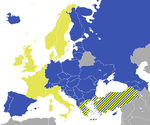
Members FullAlbania · Andorra · Armenia · Austria · Azerbaijan · Belgium · Bosnia and Herzegovina · Bulgaria · Croatia · Cyprus · Czech Republic · Denmark · Estonia · Finland · France · Georgia · Germany · Greece · Hungary · Iceland · Ireland · Italy · Latvia · Liechtenstein · Lithuania · Luxembourg · Macedonia1 · Malta · Moldova · Monaco · Montenegro · Netherlands · Norway · Poland · Portugal · Romania · Russia · San Marino · Serbia · Slovakia · Slovenia · Spain · Sweden · Switzerland · Turkey · Ukraine · United KingdomObserverFormer1 Provisionally referred to by the Council of Europe as "the former Yugoslav Republic of Macedonia"; see Macedonia naming dispute. Organisation for Economic Co-operation and Development (OECD) History Guidelines Members Australia · Austria · Belgium · Canada · Chile · Czech Republic · Denmark · Estonia · Finland · France · Germany · Greece · Hungary · Iceland · Ireland · Italy · Israel · Japan · Luxembourg · Mexico · Netherlands · New Zealand · Norway · Poland · Portugal · Slovakia · Slovenia · South Korea · Spain · Sweden · Switzerland · Turkey · United Kingdom · United States
North Atlantic Treaty Organization (NATO) History 
Structure Members World Trade Organization System Accession and membership · Appellate Body · Dispute Settlement Body · International Trade Centre · Chronology of key eventsIssues Agreements General Agreement on Tariffs and Trade · Agriculture · Sanitary and Phytosanitary Measures · Technical Barriers to Trade · Trade Related Investment Measures · Trade in Services · Trade-Related Aspects of Intellectual Property Rights · Government Procurement · Information Technology · Marrakech Agreement · Doha DeclarationMinisterial Conferences People Pascal Lamy (Director-General) · Supachai Panitchpakdi (Former Director-General) · Deputy Directors-General: Alejandro Jara · Valentine Rugwabiza · Harsha Singh · Rufus YerxaMembers Albania · Algeria · Angola · Antigua and Barbuda · Argentina · Armenia · Australia · Bahrain · Bangladesh · Barbados · Belize · Benin · Bolivia · Botswana · Brazil · Brunei · Burkina Faso · Burma · Burundi · Cambodia · Cameroon · Canada · Cape Verde · Central African Republic · Chad · Chile · PR China · Colombia · Democratic Republic of the Congo · Republic of the Congo · Costa Rica · Côte d'Ivoire · Croatia · Cuba · Djibouti · Dominica · Dominican Republic · Ecuador · Egypt · El Salvador · European Union¹ · Fiji · Gabon · The Gambia · Georgia · Ghana · Grenada · Guatemala · Guinea · Guinea-Bissau · Guyana · Haiti · Honduras · Hong Kong² · Iceland · India · Indonesia · Israel · Jamaica · Japan · Jordan · Kenya · South Korea · Kuwait · Kyrgyzstan · Lesotho · Liechtenstein · Macau² · Macedonia · Madagascar · Malawi · Malaysia · Maldives · Mali · Mauritania · Mauritius · Mexico · Moldova · Mongolia · Morocco · Mozambique · Namibia · Nepal · New Zealand · Nicaragua · Niger · Nigeria · Norway · Oman · Pakistan · Panama · Papua New Guinea · Paraguay · Peru · Philippines · Qatar · Rwanda · St. Kitts and Nevis · St. Lucia · St. Vincent and the Grenadines · Saudi Arabia · Senegal · Sierra Leone · Singapore · Solomon Islands · South Africa · Sri Lanka · Suriname · Swaziland · Switzerland · Separate Customs Territory of Taiwan, Penghu, Kinmen, and Matsu³ · Tanzania · Thailand · Togo · Tonga · Trinidad and Tobago · Tunisia · Turkey · Uganda · Ukraine · United Arab Emirates · United States · Uruguay · Venezuela · Vietnam · Zambia · Zimbabwe
- All twenty-seven member states of the European Union are also members of the WTO in their own right: Austria • Belgium • Bulgaria • Cyprus • Czech Republic • Denmark • Estonia • Finland • France • Germany • Greece • Hungary • Ireland • Italy • Latvia • Lithuania • Luxembourg • Malta • Netherlands • Poland • Portugal • Romania • Slovakia • Slovenia • Spain • Sweden • United Kingdom.
- Special administrative region of the People's Republic of China.
- Designated name for the Republic of China (commonly known as Taiwan)
Dutch Language Union National personifications Argentina: Effigies of Argentina · Armenia: Mother Armenia · Brazil: Efígie da República · Cambodia: Preah Thong and Neang Neak · Canada: Johnny Canuck · Finland: Finnish Maiden (Suomi-neito) · France: Marianne · Georgia: Kartlis Deda · Germany: Deutscher Michel, Germania · Greece: Athena, "Greece" of Delacroix · Iceland: Lady of the Mountain · India: Bharat Mata · Indonesia: Ibu Pertiwi · Ireland: Ériu, Hibernia, Kathleen Ni Houlihan · Israel: Srulik · Italy: Italia Turrita · Japan: Amaterasu · Malaysia: Ibu Pertiwi (East Malaysia) · Netherlands: Netherlands Maiden · New Zealand: Zealandia · Norway: Ola Nordmann · Pakistan: Pak Watan · Philippines: Juan dela Cruz, Maria Clara · Poland: Polonia · Portugal: Efígie da República, Zé Povinho · Russia: Mother Russia · Spain: Hispania · Sweden: Mother Svea · Switzerland: Helvetia · Ukraine: Cossack Mamay · United Kingdom: Britannia, John Bull (England), Dame Wales (Wales) · United States: Brother Jonathan, Columbia, Lady Liberty, Uncle Sam, Billy Yank (northern states) / Johnny Reb (southern states)Climate of Europe Sovereign
states- Albania
- Andorra
- Armenia
- Austria
- Azerbaijan
- Belarus
- Belgium
- Bosnia and Herzegovina
- Bulgaria
- Croatia
- Cyprus
- Czech Republic
- Denmark
- Estonia
- Finland
- France
- Georgia
- Germany
- Greece
- Hungary
- Iceland
- Ireland
- Italy
- Kazakhstan
- Latvia
- Liechtenstein
- Lithuania
- Luxembourg
- Macedonia
- Malta
- Moldova
- Monaco
- Montenegro
- Netherlands
- Norway
- Poland
- Portugal
- Romania
- Russia
- San Marino
- Serbia
- Slovakia
- Slovenia
- Spain
- Sweden
- Switzerland
- Turkey
- Ukraine
- United Kingdom
- (England
- Northern Ireland
- Scotland
- Wales)
- Vatican City
States with limited
recognition- Abkhazia
- Kosovo
- Nagorno-Karabakh
- Northern Cyprus
- South Ossetia
- Transnistria
Dependencies
and other territoriesOther entities - European Union
- Sovereign Military Order of Malta
Categories:- Netherlands
- Benelux
- Bicontinental countries
- Constitutional monarchies
- Countries bordering the Atlantic Ocean
- Dutch-speaking countries
- European countries
- Kingdom of the Netherlands
- Liberal democracies
- Northern Europe
- Western Europe
- Caribbean countries
- Member states of the European Union
- Member states of the Union for the Mediterranean
- Member states of the Dutch Language Union
- Member states of NATO
Wikimedia Foundation. 2010.

![Location of the Netherlands (dark green)– in Europe (light green & dark grey)– in the European Union (light green) — [Legend]](/pictures/enwiki/50/250px-EU-Netherlands.svg.png)

